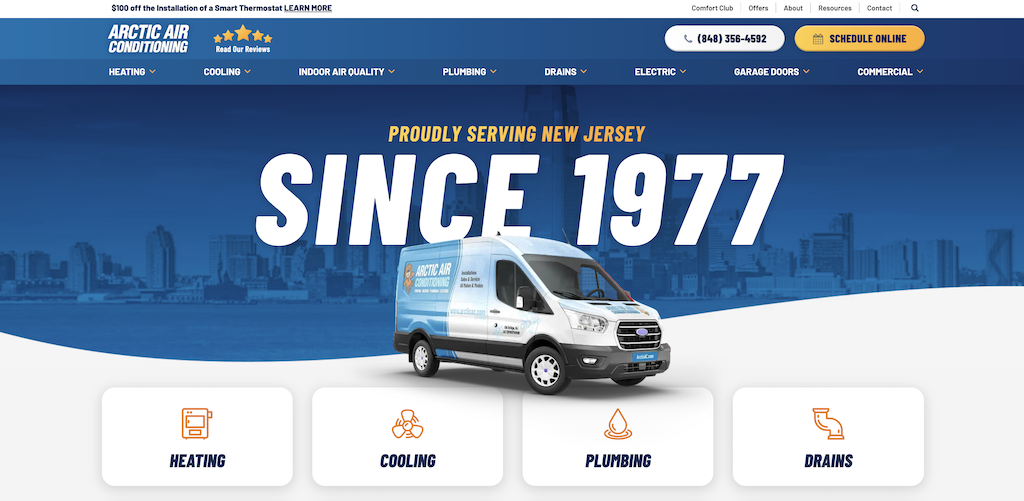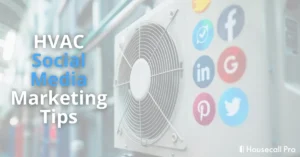Want to win more jobs with less effort?
Grow your business and send quick quotes with our home service software.

Want to see your potential revenue?
See what businesses like yours earn with Housecall Pro in 1 - 2 minutes.

If you run your own HVAC business, odds are you feel more at home in front of a furnace than a computer. However, new customers need to be able to find your business, which means you need a website that can direct traffic your way. This guide breaks down how to build an HVAC website that looks sharp, loads fast, ranks well, and helps generate leads.
Pro tip: Download our HVAC website template or use our website builder to launch a professional, SEO-friendly site fast.
Key takeaways
Here’s a quick look at building a great HVAC website:
Treat your site as a storefront: It’s your 24/7 sales tool for turning online searches into booked jobs.
Prioritize speed and design: A fast, mobile-friendly layout builds trust and keeps visitors from bouncing.
Simplify booking: Add clear contact details, service area pages, and easy-to-find “Book Now” buttons.
Automate your workflow: Use Housecall Pro to manage bookings, follow-ups, and review requests to turn website visitors into repeat customers.
What every HVAC website should include
A professional HVAC website does three things well: it builds trust, tells customers if you serve their area, and makes it easy to request service right away. So, let’s start there.
Clear contact information and calls to action (CTAs)
Add your phone number, service area, and business hours to the top of every page. Repeat them in the footer so customers never have to scroll far.
Use clear, obvious CTA buttons—think Call Now, Book Now, and Request Service—across your homepage, service pages, and about page. “The key is to remove any friction—make it so easy to contact you that customers don’t even have to think about it,” says Brian Vastola, owner of the digital marketing company MRB marketing.
Make after-hours booking easy, too. Many homeowners browse in the evening; in fact, 41% of jobs booked via Housecall Pro come in after hours. A quote request form or online booking tool keeps the door open, even when your office is closed.
Pro tip: Use Housecall Pro to automate follow-ups so every lead gets a fast response.
Local service area pages
Create dedicated pages for every major city or suburb you serve. These pages help you rank in “near me” searches and show customers you work in their area.
Start with the most popular locales and add others over time. Use local keywords, like “AC repair in Denver, CO” or “furnace replacement in Chicago” as naturally as possible in your headers and copy.
On each page, remember to include:
- A service area map to make it easy for customers to see if they fall within your boundaries
- A few photos (your team, trucks, or recent installs in the area)
- A local review (or two, for bonus points)
- A strong CTA to book
These details help you rank for “near me” searches and answer what’s often the homeowner’s first question: “Do you work in my area?”
Read more: Learn how to make your website rank higher in our HVAC SEO guide.
About page
Homeowners hire people, not logos. So, make sure you include a strong “about” page. Use this page to show your story, credentials, and values. Bonus points if you add team photos, license numbers, and any certifications like NATE or EPA 608.
If you’re licensed or insured, make it clear. Don’t forget to display your license number on your trucks, website, and business cards. “It drastically increases the level of trust,” says Sergey Nikolin, co-founder of Product Air Heating & Cooling LLC.
Reviews and testimonials
Online reviews are your digital word-of-mouth, and they matter for your reputation. Add three to five of your best reviews to your homepage, then feature relevant ones on each service page.
In the beginning, you might not have many reviews. That’s okay. Focus on building them over time. Tools like Housecall Pro automate the process by sending review requests after every job.
Remember to respond to each review, too, whether good or bad. According to BrightLocal, businesses that respond to every review are more likely to earn customer trust and new leads.
Learn more: How to respond to negative reviews
Professional visuals
Real photos from actual jobs outperform generic stock images. So, as you build your business and complete one job after another, snap pictures. Show off your team, trucks, and finished work across your website. If you can, add a before-and-after gallery page to really show off your work. Visuals communicate quality faster than text.
Stick to consistent brand colors across your uniforms, buttons, and website headers. A clean, unified look ties everything together and makes the site flow better.
Compelling copywriting
You don’t need to be a professional writer to build a great HVAC website, but you do need to sound clear and trustworthy. Write like you’re sitting at the kitchen table with a homeowner. Keep your language simple and direct. Avoid industry jargon that could confuse or overwhelm your reader. Aim for about an 8th-grade reading level.
To keep things easy to read, try these tips:
- Use clear, descriptive headers so readers can quickly find what they need.
- Break content into short paragraphs (2–4 sentences max).
- Avoid long sentences that pack in too much information at once.
- Use bullet points and tables where helpful.
Think about what your customers are searching for. Maybe it’s that they need same-day repairs or want to know the signs that point to a failing AC. Then answer those questions clearly.
Blog or resource section
You don’t need a blog or resource section on day one of your site launch, but it’s a good thing to add when you’re ready to level up. Write short, useful articles around your target customer’s needs. Think tips about spring tune-ups, fall furnace preps, and energy savings.
Every blog should naturally point back to your services with simple CTAs, like “Need help getting your system ready? Call or request service online” or “Book your seasonal tune-up today—click here to schedule.”
Add links to related service pages so readers can easily take the next step. Internal linking also helps with search engine optimization (SEO).
Tips to optimize your website for mobile use
Keep things simple: Make your website easy for users to navigate. Use large, easy-to-read fonts, and don’t go overboard with your designs and colors.
Choose a responsive layout: A responsive layout automatically scales your website to fit desktops, tablets, and phones.
Remove popups: Depending on the device, your readers might not be able to close certain popups, rendering your site unusable on a smartphone.
Compress images: Reducing the file size of the images on your website is a simple change that can make your website load faster.
Best HVAC website design practices
Well-performing HVAC websites share some of the same fundamental design practices, including:
- Fast load times: Compress images, limit unnecessary animations, and test your site using tools like Google PageSpeed Insights. Slow sites drive people away.
- Clean layout: Use plenty of white space, clear headers, and strong visual hierarchy. Every page should have a clear CTA, like a “Book Now” or “Call Today” button.
- Consistent branding: Stick with the same colors and logo you use on trucks and uniforms. Consistency builds recognition and trust.
- Mobile responsiveness: Most customers will find you on their phones. Make sure every button, image, and form works well on smaller screens.
- Accessibility: Use easy-to-read fonts, plenty of color contrast, and alt text describing the contents of images (example: “photo of HVAC technician repairing a broken air conditioner).
- SEO basics: Every page should have a clear title, a unique meta description, and internal links to your service and contact pages. These small steps help search engines understand your content and improve your local rankings.
HVAC website examples for inspiration
Reviewing high-performing HVAC websites helps you see what works. These three companies combine smart design, strong messaging, and easy conversion.
Carini Home Services

Carini’s website does a great job of combining local identity with broad service offerings. While it’s not captured in this screenshot, their site highlights “San Diego” throughout subpages and copy while also emphasizing niche offerings like mini split install. Their “Call us” CTAs are well-placed and clearly visible, and they have a solid library of blogs for homeowner education.
The takeaway: Balance design and education. Mix clear CTAs with helpful content to show customers that you’re an expert.
Bradham Comfort Services

Bradham’s site opens with a clean hero section that clearly outlines services and includes a “Schedule Appointment” button front and center. Visitors quickly find essential details like financing, licensing, and service areas. A cohesive color theme ties the whole design together and adds a sense of professionalism.
The takeaway: Lead with confidence and clarity. Make it immediately obvious what you do and how to move forward with service.
Arctic Air Conditioning

Arctic Air’s site balances breadth and clarity, covering HVAC, plumbing, and electrical services without confusing the visitor. They highlight years of experience, display prominent reviews, and emphasize their Comfort Club membership for routine maintenance. The layout feels polished yet personal thanks to a clear value statement and bright, accessible CTAs.
The takeaway: Show your credibility early. Use experience, reviews, and maintenance plans to turn trust into long-term relationships.
Should you hire a web designer or do it yourself?
A professional HVAC website doesn’t have to eat up your entire marketing budget. If you’re tech-savvy, you can build it yourself. Or, you can hire it out. The right choice depends on your budget, timeline, and comfort with technology.
DIY website builders
If you want full control, do-it-yourself platforms like Wix, Squarespace, or WordPress make it easy to get started. These drag-and-drop tools come with HVAC-friendly website templates and built-in mobile responsiveness.
| Pros | Cons |
| Affordable (plans typically cost $25–$40 per month) | Limited customization choices if you outgrow the template |
| Quick to launch | You’ll need to manage your own SEO, analytics, and performance |
| Flexible and simple to update | Booking, payments & lead tracking might require third-party add-ons |
Best for: New HVAC business owners or solo operators who want a simple but professional site they can manage themselves.
Professional web designers
A custom designer or agency can build a site that looks and performs exactly how you want. But, of course, it comes with a larger investment.
| Pros | Cons |
| Custom design created for your brand | Higher upfront cost ($3,000–$10,000 for a small business site) |
| Integrated SEO, analytics, and lead forms | Longer build time |
| Ongoing technical support and updates | Future edits may require the designer’s help |
Best for: Growing HVAC companies with multiple service areas, team photos, or advanced marketing integrations.
If you want to build a professional site that generates leads without the high agency cost, Housecall Pro can bridge the gap. You get a clean, conversion-focused design complete with automatic online booking and built-in lead capture that seamlessly integrates with your scheduling, invoicing, and payment tools.
How to optimize your HVAC website for SEO
SEO helps your business appear higher on Google when someone types in a search term like “AC repair near me”. You don’t need to master every technical detail—just focus on a few basics.
Keyword targeting
Weave service and city phrases like “AC repair in Denver, CO” or “heat pump maintenance in Lakewood” naturally into your site copy and headers. Here’s where to include them:
- Title tag (what shows up in search results)
- H1 heading at the top of the page
- 1–2 subheadings or bullet points
Write in a conversational tone and avoid keyword stuffing, which can backfire with search engines and turn off readers.
Local SEO
Make sure your local SEO strategy covers the essentials:
- Google Business Profile: Fill out every section, including services, hours, photos, and your service area.
- NAP consistency: Your business name, address, and phone number (NAP) should match exactly across your website, Google listing, and local directories.
- Service area pages: Build dedicated pages for each city or ZIP code you serve. Include local keywords, real photos, and customer reviews.
Internal linking
Adding internal links across your site helps connect related pages. It also makes navigation easier for visitors and search engines alike.
For example, your Furnace Repair page should link to your Maintenance Plans and Air Quality pages naturally. And, of course, all pages should have a CTA to book now. This keeps users moving through your site and signals relevance to Google.
Schema markup
Add basic LocalBusiness and Service schema markup to your content. This is code that gives search engines a better idea of what your site covers and can help you rank in search. Most website builders and WordPress plugins support schema automatically, but it’s a good idea to double-check that it’s in place.
Common HVAC website mistakes to avoid
Even a sleek site can fall short and lose leads if the fundamentals are off. Here are some common pitfalls to avoid:
- Hidden contact info: Make sure your phone number, hours, and service area visible on every page (ideally in the header and footer). Add a sticky “Call Now” button for mobile users, too.
- Outdated or generic pictures: Skip stock photos and use real team shots, branded trucks, and before-and-after project shots when possible.
- No clear CTA: Every page should answer “what’s next?” Use bold, consistent buttons like Book Now, Request a Quote, or Call for Service to clarify.
- Slow site speed: Large images, videos, and plug-ins can drag down performance. Compress files and use modern, reliable hosting platforms so customers won’t bounce.
- Cluttered design: Too many colors, fonts, or widgets can overwhelm visitors. Stick to a clean design with an accent color or two, uniform headers, and plenty of white space.
- No tracking or analytics: Without tracking, you can’t see which pages are pulling in leads. Set up Google Analytics and call tracking to keep things traceable.
- No automation behind the form: Even if your contact form works, leads go cold fast without follow-up. Connect online booking, campaigns, and reviews with Housecall Pro to confirm jobs, send reminders, and request feedback automatically.
Next steps for your HVAC website
Your website is your virtual storefront and the first place many customers interact with your brand. So, make that first impression a good one. A great design earns attention; fast follow-ups earn jobs.
Here’s a quick checklist to make sure you have it all covered:
- Test your forms and phone links: Submit a test form and call your listed number. Make sure you get alerts right away and that everything routes correctly.
- Add your site to your Google Business Profile: Link to your homepage and service pages so customers have access to key info quickly.
- Include your website on your socials: Social media marketing is everything, so make it easy for social media followers to become leads. Add your home page link in your bio and relevant links to your posts.
- Keep it fresh: Don’t stick with the same content indefinitely. Update your site quarterly with seasonal photos, promos, or new certifications to show you’re active and engaged.
- Ask for reviews (and feature them): Send a review request after every job. Then showcase top reviews on your homepage and service pages to help build trust.
When your website, marketing, and operations work together, you turn your visitors into customers who stick around.
Ready to build your HVAC website and start converting traffic into booked jobs automatically? Try Housecall Pro free for 14 days.






